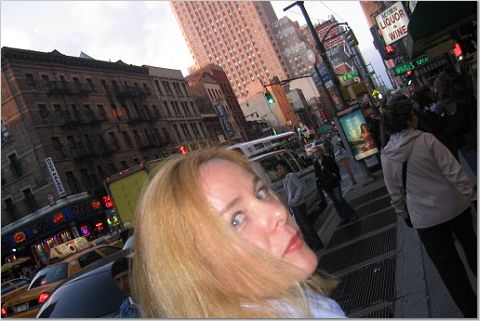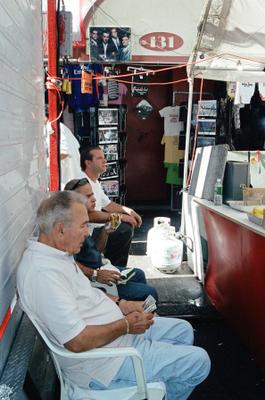
I have a new photo essay on Polis, this one of the San Gennaro festival in Little Italy last weekend. There's a link at right or click here.
New York City, Ground Up: The built, the virtual, the bizarre, the wonderful.


 I'm all for political diversity, except in my neighborhood. So please, any misplaced red-staters asking for the removal of the above painting because it offends them need to get the hell out of the E.Vil. (from Curbed, which then quotes The Villager):
I'm all for political diversity, except in my neighborhood. So please, any misplaced red-staters asking for the removal of the above painting because it offends them need to get the hell out of the E.Vil. (from Curbed, which then quotes The Villager):What better way to get going on a Friday morning than with a controversy over boobies? An argument over the display of the above painting in the window of an East Village gallery is easy fodder for those who decry the current state of the neighborhood as a yuppie playpen, but you'll be happy to know that there's at least one guy committed to keeping the East Village edgy:
In the week since the gallery’s curator put the painting in the window, several local residents have requested he remove it...“What a bunch of nerds these kids are!” said Jesse Gee, the gallery’s curator, standing inside his store on a recent Friday afternoon.
 Opening tonight at the Wessel + O'Connor Fine Art gallery in DUMBO (through Nov. 5) is an exhibition of black-and-white photographs by Wouter Deruytter, who has spent four years shooting large-scale billboards around town. The photographs don't just capture the intersection of high art and commerce, but in fact ARE the intersection of high art and commerce. (They also depict jaded New Yorkers ignoring these outsized billboards at will.)
Opening tonight at the Wessel + O'Connor Fine Art gallery in DUMBO (through Nov. 5) is an exhibition of black-and-white photographs by Wouter Deruytter, who has spent four years shooting large-scale billboards around town. The photographs don't just capture the intersection of high art and commerce, but in fact ARE the intersection of high art and commerce. (They also depict jaded New Yorkers ignoring these outsized billboards at will.)On a side note, the DUMBO gallery collective at 111 Front Street, Second Floor where the Wessel + O'Connor gallery is, has rather organically become a center for photography. I was going to write about it awhile back for the Times, but alas, I just couldn’t come up with anything new to say about DUMBO, even though the gallery collective itself is definitely worthy of ink.

 Continuing on the middle class housing squeeze, the Times has an interesting trend piece today about how programs to help middle income people buy homes have proliferated around the country. There are some good anecdotes in the piece, but with no attempt to quantify how many people have benefited or might benefit – not even in a single city where the programs have already been implemented – renders the article less than convincing. Nonetheless, here’s one program I find pretty encouraging:
Continuing on the middle class housing squeeze, the Times has an interesting trend piece today about how programs to help middle income people buy homes have proliferated around the country. There are some good anecdotes in the piece, but with no attempt to quantify how many people have benefited or might benefit – not even in a single city where the programs have already been implemented – renders the article less than convincing. Nonetheless, here’s one program I find pretty encouraging: Investment funds totaling $190 million have been created in the past year in
The funds' manager, the Phoenix Realty Group, expects to finance more than 3,000 homes in the next five years. As in many work force projects, the builders will be allowed to construct more units than typically permitted under zoning laws. The "density bonuses" enable the developer to make up the lost profit on each unit by selling more of them.
This strikes me as precisely the right way to go about providing home-ownership opportunities for middle income people: investment funds incentivizing developers to build higher-density housing around public transportation. This is killing a bunch of birds with one stone: reinvesting in urban cores, cutting down on the need to drive and consume gas, creating vibrancy and density to support further commercial investment, and hopefully relieving pressure on exurban sprawl.
The article doesn't report out what programs are being implemented in New York except to say that zoning variances have been offered to developers if they include moderate-income housing in their plans for Greenpoint and Williamsburg. That's like throwing a few bricks into the Grand Canyon.
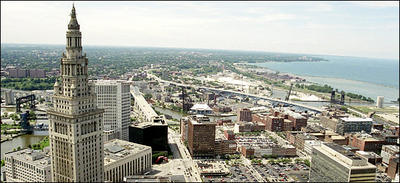 A piece I wrote for the Times about Cleveland, my hometown, is a good excuse to break from my New York City musings here at Polis. On a more personal note, I grew up in Cleveland Heights, an inner ring suburb kind of like Montclair. I moved in and out of Cleveland several times, first to Northern California, then to D.C. and finally to New York with two tours of duty in Cleveland in between. The last time I left, I knew I wasn't ever going back for a whole host of reasons. But I remember feeling almost angry at my hometown for being so lame that I couldn't possibly stay -- despite the fact that my friends and family lived there, and I owned a house that I loved -- because the job market was so shallow and the city was nearly devoid of life. I had been an editor-in-chief of a weekly paper there and worked for a member of Congress who represented Cleveland, so I knew the place like the back of my hand and had deep connections with civic life. I do hope that Cleveland really does make a comeback, and not in a boosterish, PR-kind of way, but in real way. And I'm not one of those people who thinks that's impossible. Anyone in Cleveland who doesn't think it's possible should come to New York City and tour a few neighborhoods in Brooklyn that were all but left for dead 10 years ago. Things can and do change. It's a question of, for better or worse?
A piece I wrote for the Times about Cleveland, my hometown, is a good excuse to break from my New York City musings here at Polis. On a more personal note, I grew up in Cleveland Heights, an inner ring suburb kind of like Montclair. I moved in and out of Cleveland several times, first to Northern California, then to D.C. and finally to New York with two tours of duty in Cleveland in between. The last time I left, I knew I wasn't ever going back for a whole host of reasons. But I remember feeling almost angry at my hometown for being so lame that I couldn't possibly stay -- despite the fact that my friends and family lived there, and I owned a house that I loved -- because the job market was so shallow and the city was nearly devoid of life. I had been an editor-in-chief of a weekly paper there and worked for a member of Congress who represented Cleveland, so I knew the place like the back of my hand and had deep connections with civic life. I do hope that Cleveland really does make a comeback, and not in a boosterish, PR-kind of way, but in real way. And I'm not one of those people who thinks that's impossible. Anyone in Cleveland who doesn't think it's possible should come to New York City and tour a few neighborhoods in Brooklyn that were all but left for dead 10 years ago. Things can and do change. It's a question of, for better or worse?A piece in today’s Newsday gets in on the "middle class is getting squeezed by housing prices" media jag. Wonder how those working class and poor folk are doing… but I digress:
For the first time, there are more than 1 million owner-occupied homes in the
To Be or Not To Be Broke
Gas Prices: What Goes Up Won't Come Down
 Lewis Mumford argued many years ago that skyscrapers distort land-use costs. More recently, Paul Goldberger pointed out in Up From Zero: Politics, Architecture and the Rebuilding of New York, skyscrapers have rarely if ever been profitable and have always been about power and prestige. So, despite 9/11 and the uneconomics of building more than 80 stories high, they will continue to get built ever higher. ArchNewsNow has an interesting Q&A with Ron Klemencic, chairman of the Council on Tall Buildings and Urban Habitat, who is bringing together the world's tall building experts – specialists in technology, finance, and architecture – for the Council on Tall Building’s 7th World Congress, October 16-19 in New York City, themed “Renewing the Urban Landscape.” I’m not so sure there are many people who would argue that skyscrapers can “renew the urban landscape,” but then again, isn’t that what we’re trying to do with the “
Lewis Mumford argued many years ago that skyscrapers distort land-use costs. More recently, Paul Goldberger pointed out in Up From Zero: Politics, Architecture and the Rebuilding of New York, skyscrapers have rarely if ever been profitable and have always been about power and prestige. So, despite 9/11 and the uneconomics of building more than 80 stories high, they will continue to get built ever higher. ArchNewsNow has an interesting Q&A with Ron Klemencic, chairman of the Council on Tall Buildings and Urban Habitat, who is bringing together the world's tall building experts – specialists in technology, finance, and architecture – for the Council on Tall Building’s 7th World Congress, October 16-19 in New York City, themed “Renewing the Urban Landscape.” I’m not so sure there are many people who would argue that skyscrapers can “renew the urban landscape,” but then again, isn’t that what we’re trying to do with the “Rendering by Skidmore, Owings & Merrill:
 It seems wherever there are inflated egos, so must follow inflated prices. Until they pop. (Or is that hiss?) The Times is reporting that the fifth and final restaurant to round out the
It seems wherever there are inflated egos, so must follow inflated prices. Until they pop. (Or is that hiss?) The Times is reporting that the fifth and final restaurant to round out the Conceptual Floating Art Meets Mocking Meta-Art
Robert Smithson's concept of a Floating Island -- a 30'x90' man-made island towed by a tugboat around Manhattan -- has, after three decades, become reality. Touted as the "anti-Gates," ... Smithson's Floating Island docked yesterday for the last time … conceptual art mash-up narrowly avoided.
Approaching the [Floating Island] on its starboard side was a small motorboat, affixed to which was a replica of one of the saffron-colored gates created by Christo and Jeanne-Claude that dotted
 Another summer has gone by and I never made it out to Governor's
Another summer has gone by and I never made it out to Governor's “We're not going to spend the next ten years debating what should happen here,” Randy Daniels, then the state's secretary of state and board chair of the preservation corporation, [said in 2003]. But by this spring, with progress seemingly stalled, Daniels had lost his optimism. “It takes two years to clear your throat in
he told the Times. And earlier this month, Daniels prepared to leave the board, saying … “We truly don't know what it will be but we have a general idea of what it can be.”
Two and a half years later, and all they have is a "general idea of what it can be”? Why does everything have to be planned to death? With stunning views, vast open space and beautiful historic buildings, why can’t we just do one small thing at a time there, like open it up to the public more than a few weekends in the summer? Let people slowly but surely discover the place and see what happens.
Above photo of Nolan Park on Governor's Island.
 Phat architecture schools in
Phat architecture schools in Aside from Mr. Holl's glass-and-concrete center at Pratt's
The Sunday Times had doppelganger real estate stories, one asking if it is better to rent or buy, and the other quantifying what we all know intuitively: that the middle class is getting seriously squeezed by housing prices. From the first story:
Add it all up - which The New York Times did, in an analysis of the major costs and benefits of owning and renting, including tax breaks - and owning a home today is more expensive than renting in much of the Northeast,
And from the second story:
Across the country, the median price of a single-family home has climbed 29 percent in two years, rising to $218,600 this year from $170,000 in 2003, according to the National Association of Realtors. At the same time, median family incomes rose 8 percent. The association's Housing Affordability Index dropped over the same time period, falling 15 percent in the last two years.
The second story discusses the myriad ways in which house-poor middle class people are cutting back on other things – from vacations to food – to pay for their expensive shelter, which gets to an interesting point that is made by “creative class” guru Richard Florida in his otherwise poorly executed book The Flight of the Creative Class. In addition to the ill effects of bubbles in general, he says the housing boom has been an unfortunate waste of investment money. What used to fund start-ups, high-tech R&D, and other creative pursuits is now going towards housing, which doesn’t contribute much to the long-term advancement of civilization. A roof doesn’t really have a multiplier effect no matter how expensive it is. It either keeps the elements out or it doesn’t. Only if it gets repeatedly torn off in hurricanes (!) does a roof continue to employ people.

the controversies that have plagued Libeskind’s and David Childs’ Freedom Tower, which must double as a symbol AND a giant office tower.Although meant to symbolize freedom and openness, the base of the tower was recently redesigned to resemble a windowless battle-hardened bunker to withstand a terrorist blast (emphasis added).
 With another hurricane shutting down oil refineries along the Gulf of Mexico (about 25 percent of total US capacity), experts are predicting gas could hit $4.00 a gallon or more within a couple of weeks. The newsletter of Regional Plan Association of New York, New Jersey and Connecticut has a great summary of exactly what needs to be done in light of the fact that gas will never be cheap again:
With another hurricane shutting down oil refineries along the Gulf of Mexico (about 25 percent of total US capacity), experts are predicting gas could hit $4.00 a gallon or more within a couple of weeks. The newsletter of Regional Plan Association of New York, New Jersey and Connecticut has a great summary of exactly what needs to be done in light of the fact that gas will never be cheap again:more mixed-use development should be focused on transit villages in towns along train lines in Long Island, Connecticut, the Hudson Valley and New Jersey.
 Continuing with my
Continuing with my To illustrate my point, look at the example of two current
Previous Polis posts on Coney Island (the first one outlines my misgivings about redeveloping Coney Island, the second one summarizes the city’s recent announcement of its strategic plans, the third one is a summary of New York magazine’s article about the developer Joe Sitt who wants to build ‘vegas on steroids’:
 Yesterday I made fun of MTA’s new message boards that are being installed over the next year in select subway stations. (The new message boards will – hold onto your socks now – show the date, time and when the next train will arrive. And if you drop a dime into the slot and step on the scale, it’ll tell you how much you weigh, too. Swell!)
Yesterday I made fun of MTA’s new message boards that are being installed over the next year in select subway stations. (The new message boards will – hold onto your socks now – show the date, time and when the next train will arrive. And if you drop a dime into the slot and step on the scale, it’ll tell you how much you weigh, too. Swell!)The MTA's subway modernization plan suffered a setback this week when a new communication system crashed after it was unable to handle radio traffic generated by a routine delay, officials said Wednesday.
The breakdown on Tuesday clipped contact between dispatchers and hundreds of trains ... It also delayed by weeks the opening of a $225 million midtown control center that was to replace an antiquated NYC Transit facility in
It’s easy to crack on MTA, but here’s a serious question: Is MTA’s communications infrastructure our version of a weak and eroded levee system?
*Apologies to Noam Chomsky.
 Over the next year, MTA is going to install 131 message boards in select subway stations that will tell subway riders the date, time and when the next train is coming. Whoa. Now that's some advanced sh*t. Just for fun, I think the message boards should also flash when and how much the next fare hike will be, how much money MTA has squandered on sweatheart contracts, and how many seconds have gone by since construction on the
Over the next year, MTA is going to install 131 message boards in select subway stations that will tell subway riders the date, time and when the next train is coming. Whoa. Now that's some advanced sh*t. Just for fun, I think the message boards should also flash when and how much the next fare hike will be, how much money MTA has squandered on sweatheart contracts, and how many seconds have gone by since construction on the P.S. The NY Post reports that new monitors were announced in the wake of The Permanent Citizen's Advisory Committee issuing a stinging report about MTA's communications system. How about this for an art installation project in select subway stations: Walls of TV monitors playing in a continuous loop that infamous Saturday Night Live skit of MTA personnel making garbled announcements.

This planner’s paradise – Downtown Vancouver – has exemplary urbanism, a lively social mix, and a high quality of life, all of which make it ever more attractive as … a retirement zone for baby boomers, and much less attractive as a place to conduct business.
…Lower
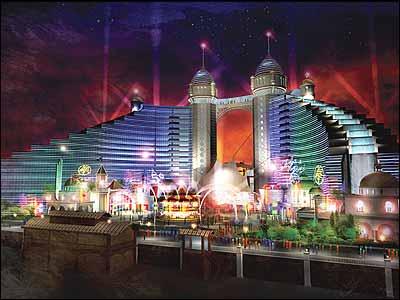 I like the idea of recreating historic
I like the idea of recreating historic Over the past few years, [Joe] Sitt’s real-estate company, Thor Equities, has quietly spent nearly $100 million buying up a huge swath of
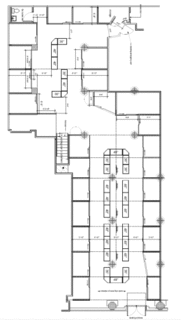 In January,
In January,
Like a curated art show, Emerge NYC, open about a month now, is a selection of emerging designers of fashion and art – jewelry, clothes, rare books, bags, etc. – arranged in what amounts to an urbanized version of a 3,500 square-foot indoor market. The 26 tiny boutiques are an affordable way for designers to get a piece of real estate on highly trafficked block in
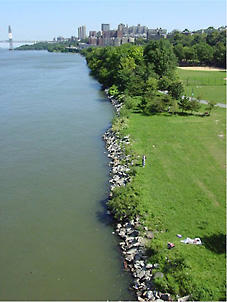 Step aside boys, the ladies are taking over the West Harlem waterfront: Bonnie A. Harken of Nautilus International Development Consulting, Donna Walcavage of Donna Walcavage Landscape Architecture + Urban Design, and Barbara Wilks of W Architecture are the women in charge of reclaiming the West Harlem waterfront for recreational use, and connecting communities along the Hudson River. They are directing two major projects currently underway, Take Me to the River, an effort to build new piers and parks between
Step aside boys, the ladies are taking over the West Harlem waterfront: Bonnie A. Harken of Nautilus International Development Consulting, Donna Walcavage of Donna Walcavage Landscape Architecture + Urban Design, and Barbara Wilks of W Architecture are the women in charge of reclaiming the West Harlem waterfront for recreational use, and connecting communities along the Hudson River. They are directing two major projects currently underway, Take Me to the River, an effort to build new piers and parks between 
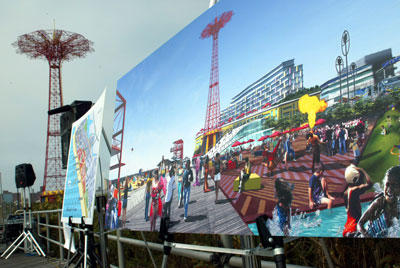 As promised, Mayor Bloomberg unveiled a “strategic plan” for spurring development at
As promised, Mayor Bloomberg unveiled a “strategic plan” for spurring development at The boardwalk improvements will get underway immediately, according to the press release, with the rest unfolding by 2009. As Curbed recently noted regarding yet another announcement about the long-awaited

 With the death knell of Santiago Calatrava’s South Street Seaport residential tower all but rung, is the era of daring residential development coming to an end before it got started? Philip Johnson’s Urban Glass House, “a discreet, twelve-story glass and steel structure” is being built at 330 Spring Street at
With the death knell of Santiago Calatrava’s South Street Seaport residential tower all but rung, is the era of daring residential development coming to an end before it got started? Philip Johnson’s Urban Glass House, “a discreet, twelve-story glass and steel structure” is being built at 330 Spring Street at 
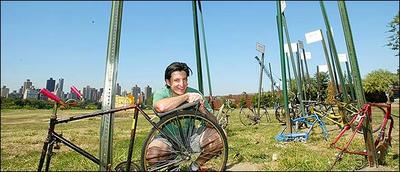
Where do all the old bicycles go: those twisted, rusted, fragmented remnants of freewheeling happiness that are chained to poles and left for dead on
A group of them, at least, have been given second acts as objets d'art by a New York-based artist who found about 100 bikes on city sidewalks this summer and took them to his own
To this burgeoning artistic trend, I add my own photo taken on St. Mark’s Place last winter (the mural at Tasty Falafel has since been painted over):

 My philosophy of writing and photography is that everything should be edited down to its essence (and that applies to life as well). Because of that, my photo essays (links at right) are a maximum of six shots each. It was a challenge to stick to this rule with my New Mexico photos, so I broke them down into three categories of six slides each. They can also be viewed in seperate windows by clicking on the links at right under My Photo Essays (these links will take you out of Polis):
My philosophy of writing and photography is that everything should be edited down to its essence (and that applies to life as well). Because of that, my photo essays (links at right) are a maximum of six shots each. It was a challenge to stick to this rule with my New Mexico photos, so I broke them down into three categories of six slides each. They can also be viewed in seperate windows by clicking on the links at right under My Photo Essays (these links will take you out of Polis): Gone for a week in
Gone for a week in “Residential real-estate prices in
“Amtrak Is Said to Be Planning a Big Fare Rise” NY Times
“Jonathan Salazar turns 4 on Sunday. Naturally, his family will have a party for him. But it will probably be a demure gathering, because it is Sept. 11.” NY Times
“Set to release on September 16th, ‘Lord of War,’ features [Chelsea Hotel resident] Ethan Hawke.” Living with Legends
